New Version:
1. Which DHCPv4 message will a client send to accept an IPv4 address that is offered by a DHCP server?
- unicast DHCPACK
- broadcast DHCPACK
- unicast DHCPREQUEST
- broadcast DHCPREQUEST
2. A company uses DHCP servers to dynamically assign IPv4 addresses to employee workstations. The address lease duration is set as 5 days. An employee returns to the office after an absence of one week. When the employee boots the workstation, it sends a message to obtain an IP address. Which Layer 2 and Layer 3 destination addresses will the message contain?
- FF-FF-FF-FF-FF-FF and 255.255.255.255
- both MAC and IPv4 addresses of the DHCP server
- MAC address of the DHCP server and 255.255.255.255
- FF-FF-FF-FF-FF-FF and IPv4 address of the DHCP server
3. Which is a DHCPv4 address allocation method that assigns IPv4 addresses for a limited lease period?
- manual allocation
- pre-allocation
- automatic allocation
- dynamic allocation
4. Which address does a DHCPv4 server target when sending a DHCPOFFER message to a client that makes an address request?
- client IP address
- client hardware address
- gateway IP address
- broadcast MAC address
5. As a DHCPv4 client lease is about to expire, what is the message that the client sends the DHCP server?
- DHCPDISCOVER
- DHCPOFFER
- DHCPREQUEST
- DHCPACK
6. What is an advantage of configuring a Cisco router as a relay agent?
- It will allow DHCPDISCOVER messages to pass without alteration.
- It can forward both broadcast and multicast messages on behalf of clients.
- It can provide relay services for multiple UDP services.
- It reduces the response time from a DHCP server.
7. An administrator issues the commands:
Router(config)# interface g0/1
Router(config-if)# ip address dhcp
What is the administrator trying to achieve?
- configuring the router to act as a DHCPv4 server
- configuring the router to obtain IP parameters from a DHCPv4 server
- configuring the router to act as a relay agent
- configuring the router to resolve IP address conflicts
8. Under which two circumstances would a router usually be configured as a DHCPv4 client? (Choose two.)
- The router is intended to be used as a SOHO gateway.
- The administrator needs the router to act as a relay agent.
- The router is meant to provide IP addresses to the hosts.
- This is an ISP requirement.
- The router has a fixed IP address.
9. A company uses the SLAAC method to configure IPv6 addresses for the employee workstations. Which address will a client use as its default gateway?
- the all-routers multicast address
- the link-local address of the router interface that is attached to the network
- the unique local address of the router interface that is attached to the network
- the global unicast address of the router interface that is attached to the network
10. A network administrator configures a router to send RA messages with M flag as 0 and O flag as 1. Which statement describes the effect of this configuration when a PC tries to configure its IPv6 address?
- It should contact a DHCPv6 server for all the information that it needs.
- It should use the information that is contained in the RA message exclusively.
- It should use the information that is contained in the RA message and contact a DHCPv6 server for additional information
- It should contact a DHCPv6 server for the prefix, the prefix-length information, and an interface ID that is both random and unique.
11. A company implements the stateless DHCPv6 method for configuring IPv6 addresses on employee workstations. After a workstation receives messages from multiple DHCPv6 servers to indicate their availability for DHCPv6 service, which message does it send to a server for configuration information?
- DHCPv6 SOLICIT
- DHCPv6 REQUEST
- DHCPv6 ADVERTISE
- DHCPv6 INFORMATION-REQUEST
12. An administrator wants to configure hosts to automatically assign IPv6 addresses to themselves by the use of Router Advertisement messages, but also to obtain the DNS server address from a DHCPv6 server. Which address assignment method should be configured?
- SLAAC
- stateless DHCPv6
- stateful DHCPv6
- RA and EUI-64
13. How does an IPv6 client ensure that it has a unique address after it configures its IPv6 address using the SLAAC allocation method?
- It sends an ARP message with the IPv6 address as the destination IPv6 address.
- It checks with the IPv6 address database that is hosted by the SLAAC server.
- It contacts the DHCPv6 server via a special formed ICMPv6 message.
- It sends an ICMPv6 Neighbor Solicitation message with the IPv6 address as the target IPv6 address.
14. What is used in the EUI-64 process to create an IPv6 interface ID on an IPv6 enabled interface?
- the MAC address of the IPv6 enabled interface
- a randomly generated 64-bit hexadecimal address
- an IPv6 address that is provided by a DHCPv6 server
- an IPv4 address that is configured on the interface
15. What two methods can be used to generate an interface ID by an IPv6 host that is using SLAAC? (Choose two.)
- EUI-64
- random generation
- stateful DHCPv6
- DAD
- ARP
16. Refer to the exhibit. Based on the output that is shown, what kind of IPv6 addressing is being configured?
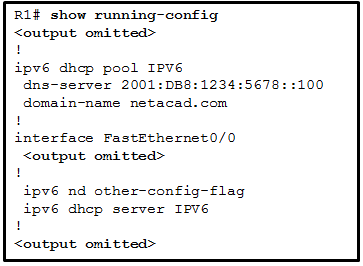
- SLAAC
- stateful DHCPv6
- stateless DHCPv6
- static link-local
17. What is the result of a network technician issuing the command ip dhcp excluded-address 10.0.15.1 10.0.15.15 on a Cisco router?
- The Cisco router will exclude only the 10.0.15.1 and 10.0.15.15 IP addresses from being leased to DHCP clients.
- The Cisco router will automatically create a DHCP pool using a /28 mask.
- The Cisco router will allow only the specified IP addresses to be leased to clients.
- The Cisco router will exclude 15 IP addresses from being leased to DHCP clients.
- The ip dhcp excluded-address command is followed by the first and the last addresses to be excluded from being leased to DHCP clients.
18. Refer to the exhibit. What should be done to allow PC-A to receive an IPv6 address from the DHCPv6 server?
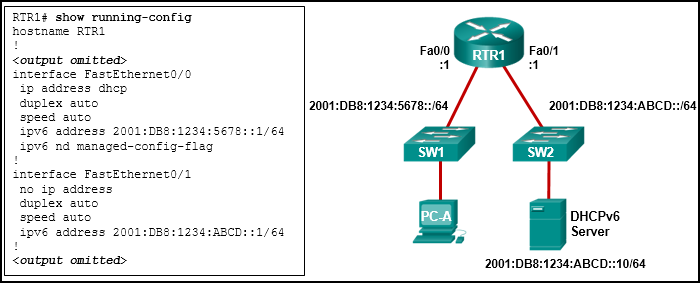
- Add the ipv6 dhcp relay command to interface Fa0/0.
- Configure the ipv6 nd managed-config-flag command on interface Fa0/1.
- Change the ipv6 nd managed-config-flag command to ipv6 nd other-config-flag.
- Add the IPv6 address 2001:DB8:1234:5678::10/64 to the interface configuration of the DHCPv6 server.
19. Refer to the exhibit. A network administrator is implementing stateful DHCPv6 operation for the company. However, the clients are not using the prefix and prefix-length information that is configured in the DHCP pool. The administrator issues a show ipv6 interface command. What could be the cause of the problem?
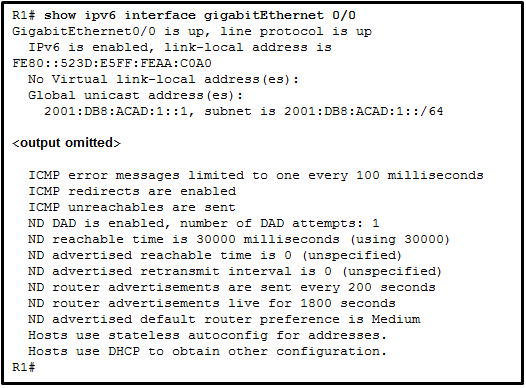
- No virtual link-local address is configured
- The Duplicate Address Detection feature is disabled
- The router is configured for SLAAC DHCPv6 operation
- The router is configured for stateless DHCPv6 operation
20. Refer to the exhibit. A network administrator is implementing the stateless DHCPv6 operation for the company. Clients are configuring IPv6 addresses as expected. However, the clients are not getting the DNS server address and the domain name information configured in the DHCP pool. What could be the cause of the problem?
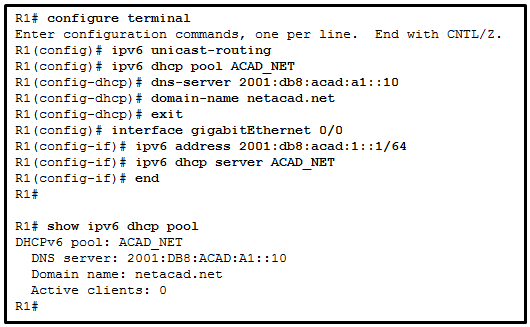
- The GigabitEthernet interface is not activated
- The router is configured for SLAAC operation
- The DNS server address is not on the same network as the clients are on
- The clients cannot communicate with the DHCPv6 server, evidenced by the number of active clients being 0
21. Fill in the blank. Do not abbreviate
Type a command to exclude the first fifteen useable IP addresses from a DHCPv4 address pool of the network 10.0.15.0/24.
Router(config)# ip dhcp
Correct Answer: excluded-address 10.0.15.1 10.0.15.15
22. Order the steps of configuring a router as a DHCPv4 Server. (Not all options are used.)


23. Match the descriptions to the corresponding DHCPv6 server type. (Not all options are used.)
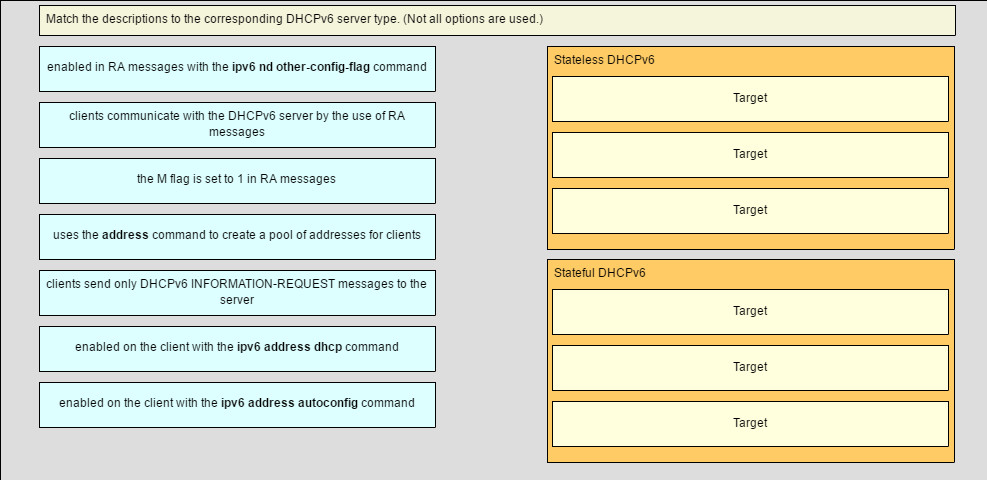

Older Version:
24. A router is participating in an OSPFv2 domain. What will always happen if the dead interval expires before the router receives a hello packet from an adjacent DROTHER OSPF router?
- OSPF will run a new DR/BDR election.
- SPF will run and determine which neighbor router is “down”.
- A new dead interval timer of 4 times the hello interval will start.
- OSPF will remove that neighbor from the router link-state database.
25. Which three statements describe the similarities between OSPFv2 and OSPFv3? (Choose three.)
- They both are link-state protocols.
- They both use the global address as the source address when sending OSPF messages.
- They both share the concept of multiple areas.
- They both support IPsec for authentication.
- They both use the same DR/BDR election process.
- They both have unicast routing enabled by default.
26. Which OSPF component is identical in all routers in an OSPF area after convergence?
- adjacency database
- link-state database
- routing table
- SPF tree
27. Which three statements describe features of the OSPF topology table? (Choose three.)
- It is a link-state database that represents the network topology.
- Its contents are the result of running the SPF algorithm.
- When converged, all routers in an area have identical topology tables.
- The topology table contains feasible successor routes.
- The table can be viewed via the show ip ospf database command.
- After convergence, the table only contains the lowest cost route entries for all known networks.
28. What is used to create the OSPF neighbor table?
- adjacency database
- link-state database
- forwarding database
- routing table
29. What is a function of OSPF hello packets?
- to send specifically requested link-state records
- to discover neighbors and build adjacencies between them
- to ensure database synchronization between routers
- to request specific link-state records from neighbor routers
30. Which OSPF packet contains the different types of link-state advertisements?
- hello
- DBD
- LSR
- LSU
- LSAck
31. What are the two purposes of an OSPF router ID? (Choose two.)
- to facilitate the establishment of network convergence
- to uniquely identify the router within the OSPF domain
- to facilitate the transition of the OSPF neighbor state to Full
- to facilitate router participation in the election of the designated router
- to enable the SPF algorithm to determine the lowest cost path to remote networks
32. What is the first criterion used by OPSF routers to elect a DR?
- highest priority
- highest IP address
- highest router ID
- highest MAC address
33. Which wildcard mask would be used to advertise the 192.168.5.96/27 network as part of an OSPF configuration?
- 0.0.0.32
- 0.0.0.31
- 255.255.255.224
- 255.255.255.223
34. What are two reasons that will prevent two routers from forming an OSPFv2 adjacency? (Choose two.)
- a mismatched Cisco IOS version that is used
- mismatched OSPF Hello or Dead timers
- mismatched subnet masks on the link interfaces
- use of private IP addresses on the link interfaces
- one router connecting to a FastEthernet port on the switch and the other connecting to a GigabitEthernet port
35. Refer to the exhibit. A network administrator issued the command show ip ospf interface on the router R2. What conclusion can be drawn?
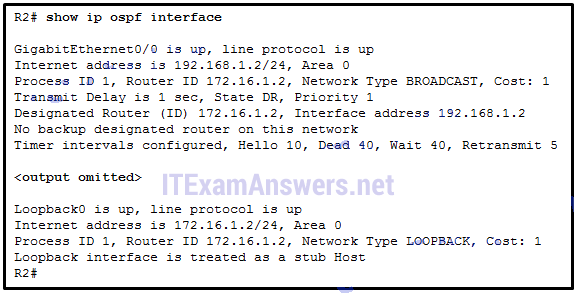
- R2 is connecting to a point-to-point network.
- R2 has not formed an adjacency with any other router.
- R2 is configured with the OSPF router-id command.
- R2 is not configured with default Hello and Dead timer values.
36. What command would be used to determine if a routing protocol-initiated relationship had been made with an adjacent router?
- ping
- show ip protocols
- show ip ospf neighbor
- show ip interface brief
37. Which OSPFv3 function works differently from OSPFv2?
- metric calculation
- hello mechanism
- OSPF packet types
- authentication
- election process
38. Which three addresses could be used as the destination address for OSPFv3 messages? (Choose three.)
- FE80::1
- FF02::5
- FF02::6
- FF02::A
- FF02::1:2
- 2001:db8:cafe::1
39. What does a Cisco router use automatically to create link-local addresses on serial interfaces when OSPFv3 is implemented?
- the highest MAC address available on the router, the FE80::/10 prefix, and the EUI-48 process
- the FE80::/10 prefix and the EUI-48 process
- the MAC address of the serial interface, the FE80::/10 prefix, and the EUI-64 process
- an Ethernet interface MAC address available on the router, the FE80::/10 prefix, and the EUI-64 process
40. A network administrator enters the command ipv6 router ospf 64in global configuration mode. What is the result of this command?
- The router will be assigned an autonomous system number of 64.
- The router will be assigned a router ID of 64.
- The reference bandwidth will be set to 64 Mb/s.
- The OSPFv3 process will be assigned an ID of 64.
41. Single area OSPFv3 has been enabled on a router via the ipv6 router ospf 20 command. Which command will enable this OSPFv3 process on an interface of that router?
- ipv6 ospf 0 area 0
- ipv6 ospf 20 area 20
- ipv6 ospf 0 area 20
- ipv6 ospf 20 area 0
42. Which command will verify that a router that is running OSPFv3 has formed an adjacency with other routers in its OSPF area?
- show running-configuration
- show ipv6 ospf neighbor
- show ipv6 route ospf
- show ipv6 interface brief
43. Fill in the blank. Do not use abbreviations.
To quickly verify OSPFv3 configuration information including the OSPF process ID, the router ID, and the interfaces enabled for OSPFv3, you need to issue the command show ipv6 protocols
44. Fill in the blank.
The election of a DR and a BDR takes place on networks, such as Ethernet networks. multiaccess
45. Fill in the blank.
OSPF uses cost as a metric.
46. Match the information to the command that is used to obtain the information. (Not all options are used.)
Question

Answer

47. Open the PT Activity. Perform the tasks in the activity instructions and then complete the task. What message is displayed on www.ciscoville.com?
- Finished!
- Completion!
- Success!
- Converged!
48. Which criterion is preferred by the router to choose a router ID?
- the IP address of the highest configured loopback interface on the router
- the IP address of the highest active interface on the router
- the router-id rid command
- the IP address of the highest active OSPF-enabled interface
49. Which command should be used to check the OSPF process ID, the router ID, networks the router is advertising, the neighbors the router is receiving updates from, and the default administrative distance?
- show ip protocols
- show ip ospf neighbor
- show ip ospf
- show ip ospf interface
50. A network administrator enters the command ipv6 router ospf 64 in global configuration mode. What is the result of this command?
- The router will be assigned an autonomous system number of 64.
- The router will be assigned a router ID of 64.
- The reference bandwidth will be set to 64 Mb/s.
- The OSPFv3 process will be assigned an ID of 64.
51. When a network engineer is configuring OSPFv3 on a router, which command would the engineer issue immediately before configuring the router ID?
- ipv6 ospf 10 area 0
- ipv6 router ospf 10
- interface serial 0/0/1
- clear ipv6 ospf process
52. Which command will provide information specific to OSPFv3 routes in the routing table?
- show ip route ospf
- show ip route
- show ipv6 route
- show ipv6 route ospf
53. Fill in the blank.
The election of a DR and a BDR takes place on multiaccess networks, such as Ethernet networks.
54. Launch PT – Hide and Save PT. Open the PT Activity. Perform the tasks in the activity instructions and then complete the task. What message is displayed on www.ciscoville.com?
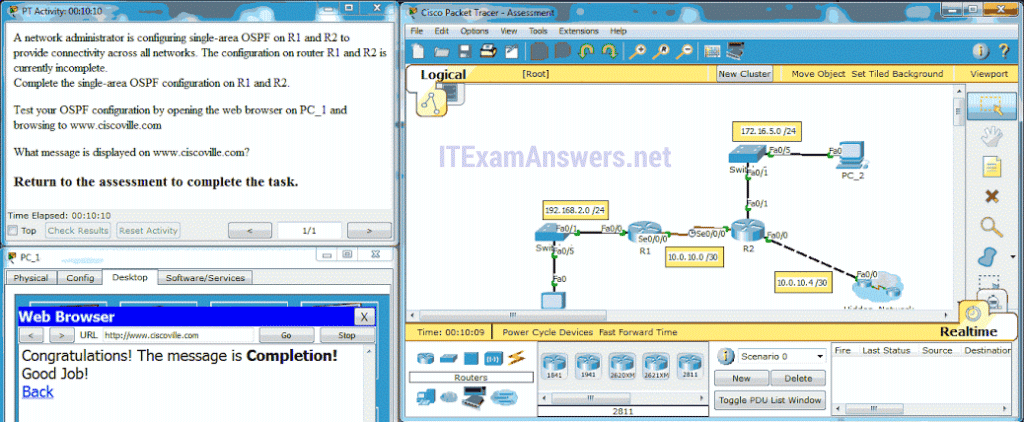
The correct configuration on R1 is: router ospf 10 network 192.168.2.0 0.0.0.255 area 0 network 10.0.10.0 0.0.0.3 area 0 The correct configuration on R2 is: router ospf 10 network 10.0.10.0 0.0.0.3 area 0 network 10.0.10.4 0.0.0.3 area 0 network 172.16.5.0 0.0.0.255 area 0
- Completion!
- Converged!
- Success!
- Finished
55. By order of precedence, match the selection of router ID for an OSFP-enabled router to the possible router ID options. (Not all options are used.)


Place the options in the following order:
Third precedence -> Loopback interface address 10.1.1.1
Fourth precedence -> Serial interface address 192.168.10.1
– not scored –
First precedence -> Configured router ID 1.1.1.1
Second precedence -> loopback interface IP address 172.16.1.1
56. Match the description to the term. (Not all options are used.)


Place the options in the following order:
This is where the details of the neighboring routers can be found. -> adjacency database
This is the algorithm used by OSPF. -> Shortest Path First
All the routers are in the backbone area. -> Single-area OSPF
– not scored –
This is where you can find the topology table. -> link-state database
– not scored –
57. What is the first criterion used by OSPF routers to elect a DR?
- Highest priority
- Highest IP address
- Highest MAC address
- Highest router ID
58. What are two reasons that will prevent routers from forming an OSPFv2 adjacency? (Choose two.)
- mismatched subnet masks on the link interfaces
- use of private IP addresses on the link interfaces
- one router connecting to a FastEthernet port on the switch and the other connecting to a GigabitEthernet port
- a mismatched Cisco IOS version that is used
- mismatched OSPF Hello or Dead timers
59. What command would be issued to determine if a routing protocol-initiated relationship has been made with an adjacent router?
- show ip protocols
- ping
- show ip interface brief
- show ip ospf neighbor
60. Match the OSPF state with the order in which it occurs. (Not all options are used.)
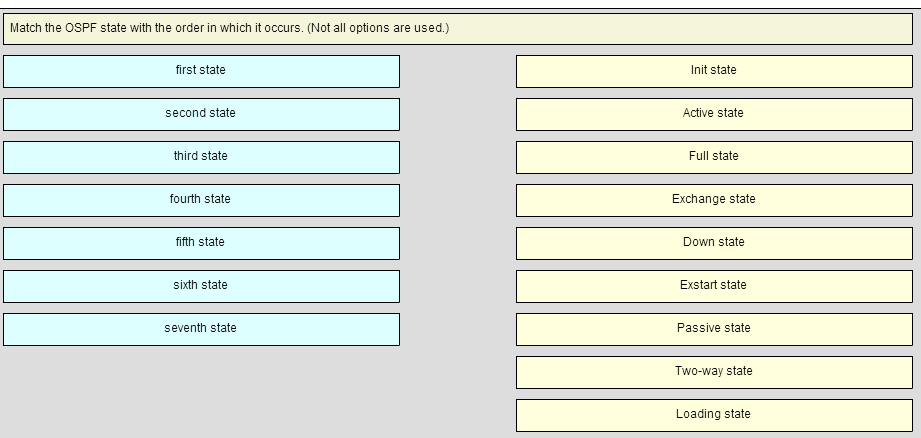
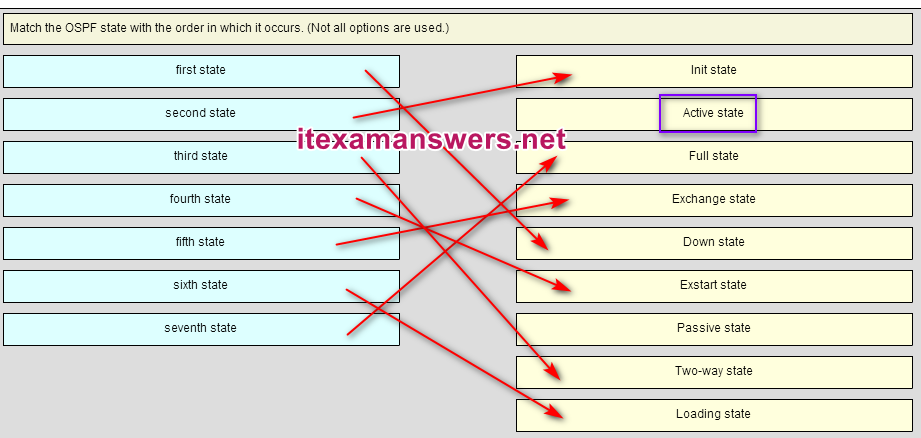
Place the options in the following order:
second state -> Init state
– not scored –
seventh state -> Full state
fifth state -> Exchange state
first state -> Down state
fourth state -> Exstart state
– not scored –
third state -> Two-way state
sixth state -> Loading state
61. An administrator has configured a DHCPv4 relay router and issued these commands:
Router(config)# interface g0/0 Router(config-if)# ip address 10.0.1.1 255.255.255.0 Router(config-if)# no shutdown Router(config-if)# exit Router(config)# ip dhcp pool RELAY Router(dhcp-config)# end
The clients are not receiving IP parameters from the DHCPv4 server. What is a possible cause?
- The IP address is incorrect for the subnet mask that is used.
- The pool cannot be named ‘RELAY’.
- The ip helper-address command is missing.
- The router is configured as a DHCPv4 client.

100% 2019 thank you.
New question
Order the steps of configuring a router as a DHCPv4 server. (Not all options are used.)
Configure a DHCP pool.
Exclude IP addresses.
Configure the routing protocol.
Define the default gateway router.
Configure a secret password.
Step 1
Step 2
Step 3
Step 4
Not sure about the answer.
Took in 2019 and scored a 100%. Thanks!
Match the descriptions to the corresponding DHCPv6 server type. (Not all options are used.)
enabled in RA messages with the ipv6 nd other-config-flag command
clients communicate with the DHCPv6 server by the use of RA messages
the M flag is set to 1 in RA messages
uses the address command to create a pool of addresses for clients
clients send only DHCPv6 INFORMATION-REQUEST messages to the server
enabled on the client with the ipv6 address dhcp command
enabled on the client with the ipv6 address autoconfig command
*Stateless DHCPv6
Stateful DHCPv6*
Dont know the answer
Place the options in the following order:
[+] enabled in RA messages with the ipv6 nd other-config-flag command
[+] clients send only DHCPv6 INFORMATION-REQUEST messages to the server
[+] enabled on the client with the ipv6 address autoconfig command
[#] the M flag is set to 1 in RA messages
[#] uses the address command to create a pool of addresses for clients
[#] enabled on the client with the ipv6 address dhcp command
[+] Order does not matter within this group.
[#] Order does not matter within this group.
Thanks
Answer To JavI
22
What is the result of a network technician issuing the command ip dhcp excluded-address 10.0.15.1 10.0.15.15 on a Cisco router?
****The Cisco router will exclude 15 IP addresses from being leased to DHCP clients.****
The Cisco router will automatically create a DHCP pool using a /28 mask.
The Cisco router will allow only the specified IP addresses to be leased to clients.
The Cisco router will exclude only the 10.0.15.1 and 10.0.15.15 IP addresses from being leased to DHCP clients.
The Cisco router will exclude 15 IP addresses from being leased to DHCP clients.
New question
What is the result of a network technician issuing the command ip dhcp excluded-address 10.0.15.1 10.0.15.15 on a Cisco router?
The Cisco router will allow only the specified IP addresses to be leased to clients.
The Cisco router will automatically create a DHCP pool using a /28 mask.
The Cisco router will exclude only the 10.0.15.1 and 10.0.15.15 IP addresses from being leased to DHCP clients.
*The Cisco router will exclude 15 IP addresses from being leased to DHCP clients.